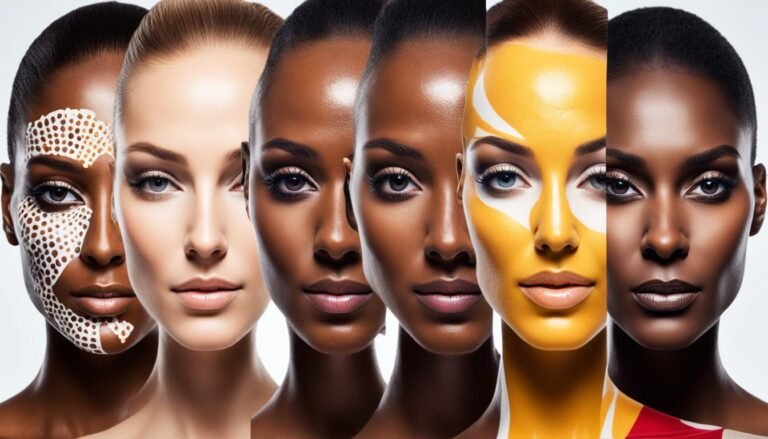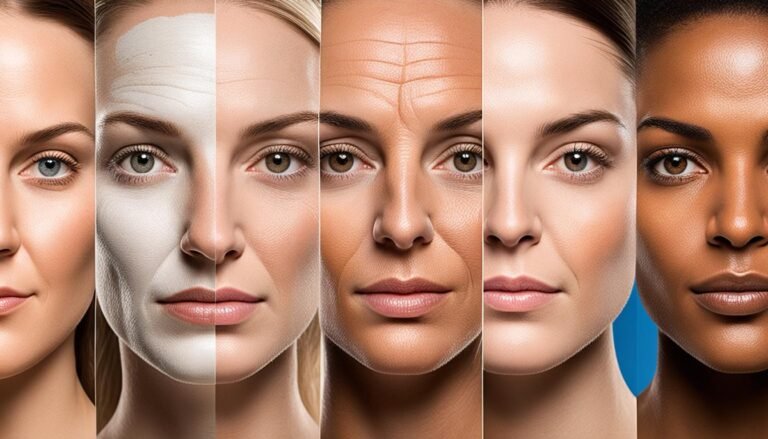What is my real skin color?
Have you ever wondered what your real skin color is? We often get accustomed to seeing ourselves in a certain way, but is that truly our natural skin tone? The answer may surprise you and could have a big impact on the way you choose skincare products and makeup shades.
There are several methods you can use to determine your real skin color, and each one can provide valuable insights into your unique complexion. By exploring these methods, you can unlock the secrets to finding the perfect products that will enhance your natural beauty and leave you feeling confident and radiant.
So, are you ready to discover your real skin color? Let’s dive in and explore the fascinating world of skin tones and undertones!
Key Takeaways:
- Determining your real skin color is crucial for selecting the right skincare products and makeup shades.
- Methods like examining your veins, observing your skin’s reaction to the sun, and using white paper and foil can help determine your skin tone.
- Eye color can provide clues about your undertones.
How to determine your skin tone
Determining your skin tone is essential for finding the right makeup shades and understanding what colors suit you best. There are several methods you can use to determine your skin tone, including:
The Vein Test: Take a closer look at the veins on the inside of your wrist. If they appear green, you likely have a warm skin tone. If they appear blue or purple, you likely have a cool skin tone.
The White Paper Test: Hold a bright white piece of paper against your face in natural light. Observe the color difference between your skin and the paper. If your skin appears yellowish, peachy, or golden, you have a warm skin tone. If your skin appears pink, rosy, or bluish-red, you have a cool skin tone.
The Jewelry Test: Try on gold and silver jewelry. If gold jewelry enhances your complexion and makes you look radiant, you likely have a warm skin tone. If silver jewelry complements your complexion and brings out your features, you likely have a cool skin tone.
The Sun Exposure Test: Pay attention to how your skin reacts to sun exposure. If you tan easily and rarely burn, your skin tone is likely warm. If you burn easily and struggle to tan, your skin tone is likely cool.
Determining your skin tone can help guide your choices in makeup, hair color, and clothing to accentuate your natural beauty. Understanding your skin tone will allow you to make informed decisions when choosing products that flatter and enhance your complexion.
To help you determine your skin tone, here’s a table summarizing the different methods:
| Test | Indication | Warm Skin Tone | Cool Skin Tone |
|---|---|---|---|
| Vein Test | Veins appear | Green | Blue or purple |
| White Paper Test | Skin color against white | Yellowish, peachy, or golden | Pink, rosy, or bluish-red |
| Jewelry Test | Looks better in | Gold | Silver |
| Sun Exposure Test | Reaction to sun | Tans easily, rarely burns | Burns easily, doesn’t tan much |
Now that you know how to determine your skin tone, you can confidently choose the right colors and shades that will complement and enhance your natural beauty.
How to determine your skin undertone
Determining your skin undertone is crucial when it comes to finding the perfect makeup shades that complement your complexion. By understanding your undertone, you can choose the right colors that enhance your natural beauty and create a harmonious look.
There are several methods you can use to determine your skin undertone:
- Color Analysis: One effective method is the color analysis, which involves comparing your skin to a color swatch or standardized chart. This helps identify whether you have a fair, light, medium, or dark skin tone. By matching your skin color to the closest shade on the chart, you can determine your undertone.
- Natural Light Test: Another way to determine your undertone is by examining your skin in natural daylight. Natural light provides the most accurate representation of your skin’s true color. Look for any subtle undertones such as pink, yellow, or peachy hues that may be present.
- Sun Exposure Test: Observing how your skin reacts to sun exposure can also offer clues about your undertone. If you tend to tan easily and rarely burn, it suggests a warm undertone. On the other hand, if you burn easily and struggle to tan, it indicates a cool undertone.
By combining these methods, you can confidently determine your skin undertone and choose makeup shades that complement your complexion. Remember, embracing your natural undertone is the key to achieving a flawless and radiant look.
Conclusion
Determining your real skin color and undertone is crucial for finding the perfect skincare and makeup match. By using the methods mentioned in this article, such as the vein test, white paper test, and sun exposure test, you can accurately identify whether you have a warm, cool, or neutral skin tone and undertone.
Understanding your skin’s true colors enables you to choose the right products that will enhance your natural beauty and provide the best results for your skin. Whether you need a foundation, concealer, or lipstick, knowing your real skin color and undertone will ensure a seamless and flattering application.
Embrace your real skin color and embrace your unique beauty. By finding the perfect skincare match that works for you, you can confidently showcase your authentic self and radiate confidence. Take the time to determine your real skin color, uncover your undertone, and enjoy the benefits of a personalized skincare and makeup routine tailored specifically to you.






